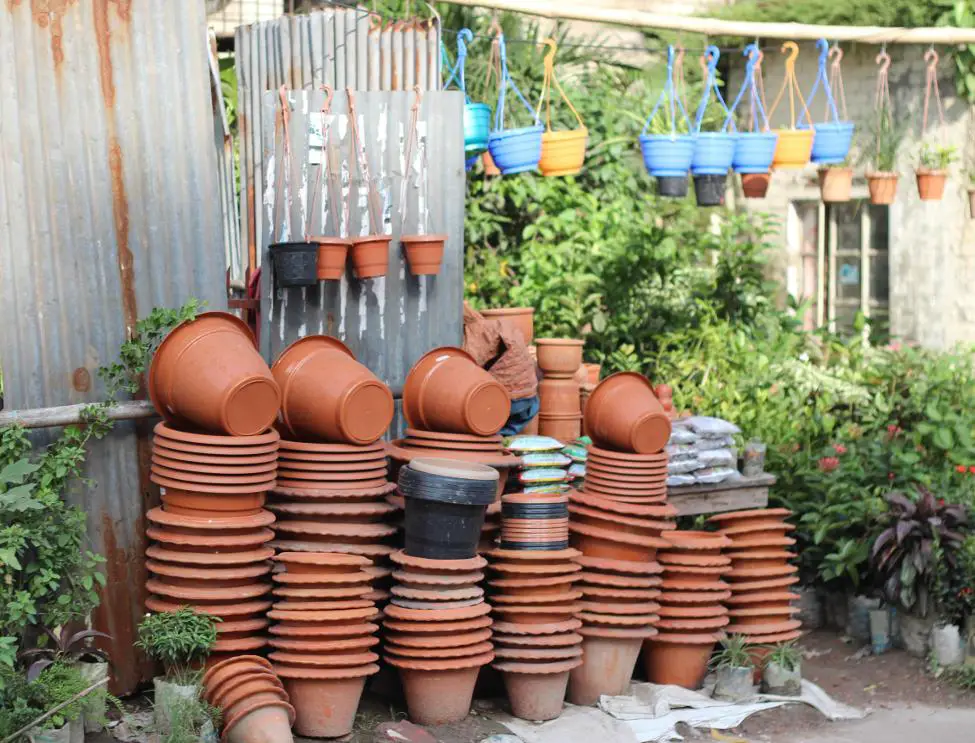If you have limited space in your garden, there is still an abundance of produce you can grow in containers. If you live in the city, you can grow vegetables using the smallest of balconies or patios as well as indoor windowsills. They can also be highly decorative, all sorts of colours and sizes of pots are available, along with eye-catching mulches to place on top of the compost such as broken shells or glass beads.
Types of containers for your garden
Clay and terracotta
These come in many different sizes and designs. When buying, make sure that they are frost-proof rather than frost-resistant to avoid them developing cracks during hard winters. If you stand the pot on ‘feet’, there will be less risk of frost damage.
Terracotta and clay pots also have a tendency to dry out quicker. Line the inside of the pot to help contain moisture.
Metal containers
These give a more contemporary look, or you can pick up old galvanized jugs and buckets in a junk shop or market for a rustic or vintage effect. They have fewer tendencies to dry out, although they conduct the heat and cold more readily.
Wooden containers
Old fruit boxes, window boxes or wooden tubs are very attractive. If the fruit boxes have gaps in the sides, line them first with polythene (try using an old, cut-up compost bag or a bin liner), cutting holes in the bottom for drainage before filling up with compost.
Plastic containers
These are light, making them easy to move, and practical, being less prone to drying out than terracotta and unaffected by frost. Look out for attractive plastic pots that imitate terracotta convincingly.
Hanging baskets
Some plants grow very well in hanging baskets, such as herbs or tumbling tomatoes.
Strawberries also love hanging baskets, they make for very easy picking and keep the fruit above ground level away from pests such as mice.
Other containers
Look for any recycled materials that you may have around the house, old tins, buckets, and kettles all work well. Make drainage holes in the bottom, and if they are to sit inside on a windowsill, place them in a tray to catch the water as it drains out of the bottom.
Have a look at this article for some great innovative garden ideas.
How to choose the right pot size
When choosing a container, make sure that it is the right size for the type of plant you are going to grow. Root vegetables will need deep planters, while salads, spinach and beetroot work well in shallow pots, as the roots sit near the top. Tomatoes or courgettes need larger pots to accommodate their roots and will also possibly require cane supports, depending on the variety you choose
Do containers need drainage holes?
Most plants need good drainage and don’t like to be waterlogged. If your containers haven’t already got drainage holes in the base, you’ll need to drill some. Place broken pieces of stone, old crocks or a broken-up old polystyrene planter in the base of the containers before filling them with a compost that offers good drainage.
How to water your plants in containers
Plants in containers tend to dry out more easily and will therefore need regular checking for moisture. A windowsill acts as a mini greenhouse for growing plants and so moisture levels will need checking very frequently.
Bear in mind that if your pots are kept on a paved patio, the stone or bricks will absorb heat during the day and be released at night, so the plants are likely to be in a warmer environment than if planted in the ground.
Don’t rely on rainfall to keep the plants adequately watered, as the rain will often not penetrate the leaves or be heavy enough to penetrate down to the roots. There are water-retaining gels or powders that can be mixed with the compost when planting up your containers, which swell up when wet and then release water gradually back into the compost.
Decorative mulches or gravel can also be placed on the surface of the compost, which will help retain moisture. Smaller pots will dry out more quickly than larger pots.
Growing vegetables and herbs in a variety of containers is an effective and attractive way of gardening in a small space.
Note: Clicking the above links will take you to Amazon.com where you’ll get additional product information. If you make a purchase, we may earn a commission at no additional cost to you.
